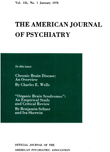Abstract
One hundred thirty-two cases of active pulmonary tuberculosis from a patient population of 10,500 in 5 state hospitals were studied. Seventy-one of these were from the Mayview State Hospital servicing Pittsburgh. Biostatistically consistent comparisons could thus be made with data obtained for known cases of active tuberculosis in Pittsburgh not confined to mental hospitals. To answer those questions posed in the introduction:
1. There is a prevalence rate of 13 cases per thousand of actively tuberculous patients in the population from 5 of Pennsylvania's state psychiatric hospitals.
The prevalence rate was 21 cases per thousand of active tuberculous patients at Mayview State Hospital. This population was derived entirely from Pittsburgh where the prevalence rate for active tuberculosis in the general population not in mental hospitals was 2.7 cases per thousand. The tuberculosis mortality rate for these patients was 270 per 100,000. Male mortality rate was 300, and female rate 240 per 100,000. The general public's crude tuberculosis mortality rate was 10 per 100,000.
2. In 19 of our cases, no chronological primacy could accurately be assigned either disease.
Of the others, more than 90% had been confined to mental hospitals for several years prior to their tuberculosis being discovered. Only 2 of 102 of these cases had minimal tuberculosis when it was discerned.
3. The median length of time in years between the hospitalization for severe mental illness and the discovery of the complicating tuberculosis was 15.8 years for the males and 10.0 years for the females. When severe mental illness occurred as a complication in individuals initially hospitalized for their tuberculosis, the median time in years between hospitalizations for the tuberculosis and psychiatric disturbance was 4.0 years for the males and 2.25 years for the females.
4. The actively tuberculous in the general population of Pittsburgh not confined to mental hospitals had a median age of 46.7 years; they were predominantly males and a relatively greater prevalence of active tuberculosis was found in the non-white population.
Our tuberculosis patients derived from this urban area had a median age of 53.8 years. The male to the female ration approaches 2 to 1. The non-tuberculous hospitalized psychiatric patients in this group have a median age of 57.6 years and 52.9% of these patients are females. There was no statistically significant racial difference between the tuberculous and non-tuberculous psychiatric hospital populations.
5. Almost all the actively tuberculous psychiatric population hospitalized in this series suffered from functional psychotic disturbances (especially schizophrenic reactions) or from chronic brain syndromes, but there were no psychiatric peculiarities consistently applicable to the tuberculous.
If we are ever to eradicate tuberculosis from our state hospital population, earlier detection and more effectual control of all hygienic factors in the environment of hospitalized patients are imperative. The control of this major epidemiologic disease must be administered by those conversant with it.

